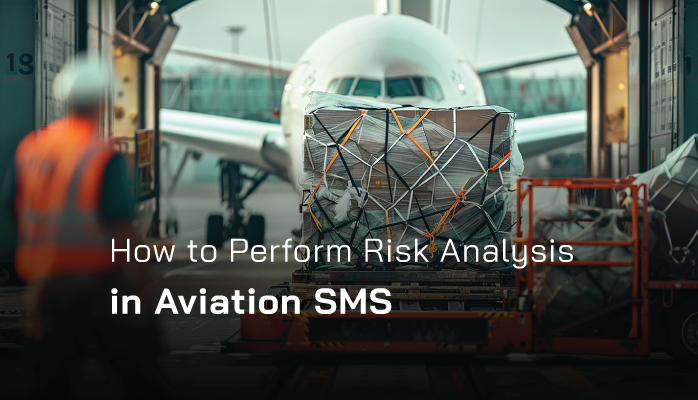What Are You Looking for When Performing Risk Analysis

During the risk management process in an aviation safety management system (SMS), one of the expected tasks is to analyze the risk of hazards associated with
- reported safety issues;
- audit findings; and
- proposed operational changes.
When you perform risk analysis on whatever type of safety issue in aviation SMS, your goal is to understand how and why the underlying issue affects risk exposure in your organization. Understanding how and why an issue affects risk exposure is the logical step that leads to being able to assess how much it affects risk exposure.
Related Aviation SMS Risk Analysis Articles
- Difference Between Hazard Risk Assessment and Hazard Risk Analysis
- 5 Core Rules for Risk Analysis in Aviation SMS
- Everything You Need to Know About Risk Analysis in Aviation SMS
Risk Analysis Leads Way to Risk Assessments
In risk analysis you attempt to find out all of the information you need in order to perform a risk assessment. The main questions you need to answer when analyzing the issue are:
- What is the narrative of the issue (i.e., a description of what happened)?
- Is the issue in question a hazard, a negative outcome, a benign issue, a root cause, etc.?
- How severe is this problem?
- Given current operations, what are the chances of this issue happening again?
- In this issue, what is/are the:
- Primary hazard?
- Most likely negative outcome?
- Root causes and other contributory factors?
Performing risk analysis is a process of attempting to answer these questions.
Tools to Perform Risk Analysis
Several useful tools help you perform risk analysis in aviation SMS, including:
- Fishbone diagrams;
- 5 Whys Analysis;
- Issue Life Cycle Analysis;
- Risk Statement (hazard/risk identification);
- Bowtie analysis (advanced);
- Decision trees;
- Shortfall analysis (used to identify potential corrective actions).
These tools help safety teams answer all questions required in a good risk analysis.
Related Aviation SMS Risk Analysis Articles
- Safety Risk Management Risk Analysis Requirement
- Top Charts and Tools to Help With Risk Analysis in Aviation SMS
- What Is Process for Risk Analysis in Aviation SMS
First Steps in Risk Analysis: What Is the Current Issue? (Hazard, Outcome, etc.)
The first thing you need to do when analyzing your issue is get an idea of what kind of issue you are dealing with. If it is a reported issue, the “problem” that is reported can be anything falling within the life cycle of hazard and risk occurrence, such as
- Benign problem or condition (“faulty hydraulic door stopper”);
- A root cause to a potential problem (“faulty runway bulb causing glaring light”);
- A potentially unsafe situation/behavior (“pilot acting sleepy”);
- A potential threat (“flock of geese flying within 1 mile of primary runway”);
- A hazard occurrence (“runway incursion”); or
- An actual negative outcome (“water spilled on a primary server, causing it to malfunction”).
All reported issues will fall somewhere within this spectrum. You need to ascertain what the issue is in order to proceed in the aviation SMS risk management process. Having a thorough issue narrative describing what happened is very helpful for analysis.
For our analysis, we will use a boilerplate example narrative: “Ground ops driver lost control of the ground ops vehicle because he was tired, the runway markings were unclear, and it was dark out. He crashed into a light pole, damaging the vehicle and breaking his leg. No one else was hurt.”
Analyze Issue for Primary Hazard

The hazard occurrence will be your starting point for identifying the root causes and negative outcomes. If the reported safety issue is already the actual hazard occurrence, then you already have your work cut out for you. Oftentimes the issue that is reported is NOT the actual hazard occurrence and is instead a negative outcome, in which case, we need to look further.
To find the hazard occurrence, you need to look at the narrative of the issue. The narrative of the issue described what happened, from start to finish. You may consider this a sequence of events if you are looking at this from an investigator's perspective. In this narrative, you are looking for the point at which a dangerous condition arises. This is:
- An object, situation, or circumstance that poses an unacceptable level of danger;
- A condition that arises only once in the narrative;
- May lead to (or did lead to, in the event that a negative outcome is reported) a negative outcome if not mitigated; and
- A condition that arises from identifiable mechanisms (objects, behaviors) that occurred earlier in the narrative.
If the reported issue is a:
- Negative outcome, you will need to “look backward” in the narrative to find the hazard; or
- Root cause or other threat, you will need to “project forward” to imagine the most likely hazard occurrence.
Related Aviation Safety Hazard Articles
- Difference Between Hazards, Risks & Control Measures in Aviation SMS
- How to Identify Hazards and Assess Risks in Aviation SMS
- 4 Pillars | What Is Hazard Identification in Aviation SMS
Analyze Issue for Most Likely Negative Outcome
After identifying the hazard, you need to identify the most likely negative outcome that will arise from that hazard. If the reported issue already has a negative outcome, then your work is cut out for you.
Otherwise, you will need to establish what the most likely negative outcome is given the hazard. If the hazard you identified has already been identified and documented in your operational risk profile, then ideally you should have already had some likely negative outcomes listed.
After establishing the most likely negative outcome, you can complete your “If…Then…” risk statement:
- If [identified hazard],
- Then [identified most likely negative outcome].
For example, in the case of the example listed earlier, the negative outcome is the driver hitting the light pole, damaging the vehicle, and breaking his leg.
Analyze Issue for Root Causes
An integral part of risk analysis is analyzing the issue for root causes.
Root causes are the existing conditions and behaviors (i.e. mechanisms) that conspire together to lead to hazard occurrence. Another way of saying it is that root causes play a “causal” role in hazard occurrence. Proactive risk mitigation strategies are used to identify root causes and stop them from becoming a hazard occurrence.
Root causes will often be used to explain WHY the hazard occurred. For example, in the narrative, “Driver lost control of the ground ops vehicle because he was tired, the runway markings were unclear, and it was dark out,” the root causes are the three things after “because.”
It’s useful to have a root cause statement that works like this:
- [Hazard occurrence] occurred,
- Because [identified root causes].
You should document your root causes, such as classifying them using an industry-accepted classification schema. Classifying identified roots increases your organization's data mining capabilities and facilitates your aviation SMS's future predictive risk management processes.
Classifying root causes becomes very easy when using an SMS database to document your risk analysis activities.
Related Articles on Root Causes in Aviation SMS
- How to Conduct Root Cause Analysis in Aviation SMS
- Is Root Cause Analysis Proactive or Reactive?
- Safety Chart: Monitor Root Causes' Contributing Factors in Aviation SMS
Understand Contributory Factors
Contributory factors are similar to root causes, but whereas root causes directly result in problems (i.e. they are “causal”), contributory factors are simply other factors that may intensify or “speed up” the transition from root causes to hazard occurrence.
To use the example earlier, you could make the case that “darkness” is not a root cause, but rather a contributory factor. Some other contributory factors in the previous example might be that:
- The driver didn’t normally drive this route;
- The driver didn’t normally work during this shift;
- The supervisor who was supposed to assist the driver was out sick;
- And so on.
As you can see in these examples, these are other factors that contributed to the driver losing control of the vehicle but did not directly appear as “causal” in losing control.
You may be able to identify contributory factors in the narrative, or you may have to inquire about more information. You should document your contributory factors, such as via classifications, for later data mining.
Analyze Issue for Risk Severity

Once you understand the entire scope of the issue, you need to analyze the severity of the negative outcome. The steps are as follows:
- List your criteria for severity on your risk matrix, such as:
- Financial damage
- Human injury
- Mission obstruction
- Environmental damage
- Ascertain the number of damages in the negative outcome for each of your criteria, such as:
- Damaged vehicle = $22,000
- Moderate injury, requiring hospitalization
- No obstruction to mission
- Minor damage to light pole
- Match up the damage with the level of severity defined in your risk matrix, such as:
- Severity level 4
- Severity level 3
- Severity level 2
- Severity level 1
Then, during risk assessment you will use this analysis to decide on the overall severity of the issue under analysis. Risk assessments are routinely performed using risk matrices in every aviation SMS that I've seen. If you don't have a risk matrix, or your risk matrix does not align with your operations, you should consider revising the risk matrix.
Related Aviation Risk Matrix Articles
- What Is a Risk Matrix and Risk Assessment in Aviation SMS
- How to Define Your Risk Matrix in Aviation SMS
- How to Define Severity and Likelihood Criteria on Your Risk Matrix
Analyze Issue for Risk Likelihood
You also need to analyze the issue for the future likelihood that the negative outcome will occur in the event of the hazard occurrence. The steps for this are:
- Review trends and historical data on similar issues to establish how common this occurrence actually is; and
- Review existing risk controls that are used to mitigate this negative outcome.
Based on this analysis, you should have a good idea whether this negative outcome is frequent, somewhat common, rare, etc. You will use this analysis during risk assessment to assign a likelihood level to the issue.
Final Thoughts on Risk Analysis in Aviation SMS
There will be many occasions for safety professionals to conduct a risk analysis while managing the aviation SMS. The risk analysis process provides safety managers with a repeatable process to identify and analyze potential safety concerns that could negatively impact safe operations.
After the risk analysis, your next steps will be to
- determine alternative risk mitigation strategies,
- implement accepted risk mitigation strategies; and
- continue to monitor the system for failing risk controls.
Aviation risk management is an iterative process.
When the same type of issue presents itself again, you will have to go through the process anew. Consequently, proper identification of potential issues, threats, and vulnerabilities that can negatively affect operations is the framework upon which to build your SMS's risk management activities. Operators who have the ability to effectively monitor and identify emerging hazards and risks will become more successful in their risk management activities.
The ability to manage risk and monitor your systems will always be dependent on available tools. If your SMS is managed using spreadsheets, your effectiveness in monitoring your systems will be limited. An aviation SMS database is not required but is definitely recommended for the best results.
These short demo videos will provide an overview of how your company can benefit from a low-cost, commercially available SMS database.
Last updated January 2025.








